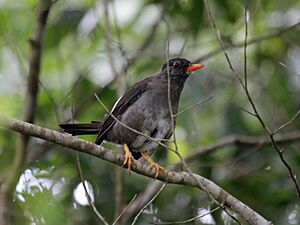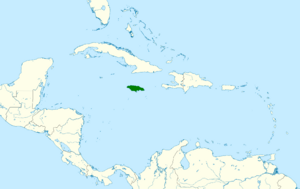White-chinned thrush facts for kids
Quick facts for kids White-chinned thrush |
|
|---|---|
 |
|
| Conservation status | |
| Scientific classification | |
 |
The white-chinned thrush, also known as the hopping dick in Jamaica, is a type of bird. Its scientific name is Turdus aurantius. This bird is part of the Turdidae family, which includes many thrushes. You can only find this bird in Jamaica, where it is very common. It lives in moist lowland forests, mountain forests, and even in areas where forests have been changed by people.
About the White-chinned Thrush
This bird was first officially described in 1789. A German scientist named Johann Friedrich Gmelin gave it its scientific name, Turdus aurantius. The name Turdus comes from Latin and means "thrush." The word aurantius is Modern Latin for "orange-coloured." This name likely refers to the bird's orange beak and legs.
What Does It Look Like?
The white-chinned thrush is about 24 to 26.5 centimeters long. Both male and female birds look very similar.
- Head: The face, top of the head, and back of the neck are black.
- Body: The rest of its upper body is dark grey.
- Wings: It has two small white patches on its wings.
- Underparts: The chin is whitish. The rest of its underside is mid-grey, with the lightest feathers on its belly.
- Beak and Legs: Its beak, legs, and feet are all bright orange.
- Eyes: Its eyes are brown.
The only other thrush you might see in Jamaica is the white-eyed thrush. You can tell them apart because the white-eyed thrush does not have the white wing patches or the orange beak. In Jamaica, people sometimes call this bird "hopping dick" or "chick-me-chick."
Life and Habits
White-chinned thrushes usually breed between May and August. They build their nests in shrubs. The nest is a bit messy, made from leaves, plant fibers, and small twigs. Inside, it's lined with softer materials.
A female thrush usually lays 2 to 4 eggs. The eggs are dull whitish or pale green with reddish-brown spots. The female bird sits on the eggs to keep them warm for about 16 days. These birds often raise two groups of chicks in one breeding season.
Gallery




